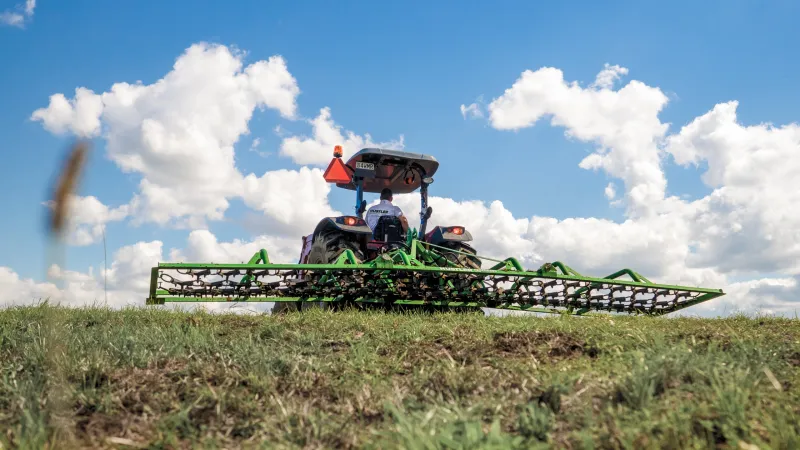In pasture management, is harrowing truly necessary? When is the best time to harrow? Will this operation increase your management costs, or will it actually bring greater returns? These are questions that often trouble farm and ranch managers. Over time, the structure of the soil and the growth cycles of the pasture will change. Without understanding the correct steps for harrowing, you might waste time, resources, and even risk damaging the pasture’s ecosystem. That’s why it’s crucial to understand the real benefits of harrowing and how to carry it out efficiently.
Harrowing is often overlooked, but it is a vital task. It not only directly affects the growth of your pasture but also impacts the health of your livestock and the overall productivity of your operation. Residue on the surface, compacted soil, and the spread of weeds are common problems that farm managers face, and harrowing is the key step to solving them. If you want healthier grass and higher-quality pasture, harrowing is essential.
Now, let’s explore the benefits of harrowing. We will help you understand why harrowing is so important and guide you through the specific steps to make informed decisions based on your pasture’s condition. Harrowing is not just a technical task; it’s a strategic choice to boost your pasture’s productivity.

Contents
The Core Issues of Harrowing Pastures and Hayfields
First, we need to clearly understand the main purpose of harrowing. In pasture management, the growth environment and quality of the grass directly impact the health and productivity of livestock. After a period of grazing or harvesting, the soil surface often hardens, and the ground may be covered with old grass and plant debris. This not only slows the sprouting of new grass but also blocks air, water, and nutrients from penetrating the soil. Especially in hayfields, leftover grass can increase the risk of pests and diseases, lowering the quality of the grass.
When you notice poor grass growth, an increase in weeds, or hardened soil on the surface, harrowing becomes necessary. Harrowing breaks up the soil, removes leftover plant debris and other obstacles, and improves the soil’s aeration. This creates a better environment for new grass to grow. In hayfields, harrowing helps spread dry grass evenly, allowing it to decompose faster and reducing the risk of pests and diseases.
What Problems Can Harrowing Solve?
Remove Surface Debris and Improve Grass Quality
After long periods of grazing or hay harvesting, a large amount of plant residue and weeds often accumulate on the ground. These can block the growth of new grass and even lead to pest and disease outbreaks. By harrowing, you can effectively clear away these obstacles, allowing fresh grass to get more sunlight, air, and nutrients. This significantly boosts the quality of your pasture.
Improve Soil Structure and Enhance Water and Nutrient Penetration
Soil that hasn’t been turned for a long time often becomes compacted. This compaction blocks water and nutrients from reaching the grass roots, preventing them from getting the support they need. Harrowing loosens the soil, breaks up the compacted surface, and allows water and nutrients to penetrate more easily, helping the grass grow stronger and healthier.
Reduce the Spread of Weeds and Pests
Weeds and pests tend to thrive in areas with accumulated plant debris. Harrowing disrupts these hiding places, slowing down the spread of weeds and reducing pest infestations. This helps protect the health of your pasture.
Increase Overall Pasture Productivity
A well-managed pasture provides higher-quality forage for livestock. This improves milk production, weight gain, and overall livestock health while reducing the risk of disease. In the long run, harrowing is a high-return investment that boosts the overall productivity of your pasture and reduces feeding costs.
How to Harrow Effectively Based on Actual Conditions
1. Assess the Condition of the Pasture and Determine the Timing
Not every pasture needs to be harrowed all the time. Knowing when to harrow is crucial for managing efficiency and controlling costs. You need to regularly assess the condition of your pasture. Check if the soil is compacted, if grass growth is being hindered, or if weeds are spreading too much. If you notice weak root systems, slow grass regeneration, or large areas taken over by weeds, it’s probably the right time to harrow.
2. Choose the Right Harrowing Tools
The choice of harrowing equipment depends on the size of your pasture, soil conditions, and your goals for harrowing. For smaller pastures, you can use manual or tractor-pulled tine harrows, which are suitable for turning over the topsoil and clearing surface debris. For larger pastures or when deeper soil work is needed, a rotary harrow or heavy-duty tine harrow is more suitable. These tools can break up compacted soil more deeply, allowing better penetration of water and nutrients.
3. Set the Right Frequency and Timing for Harrowing
The frequency of harrowing depends on the type of grass and the intensity of pasture use. Typically, harrowing once or twice a year is enough to keep the pasture healthy, especially in early spring when grass begins to grow, or in late fall after the growing season ends. Avoid harrowing during the rainy season or when the soil is too wet, as this can damage the soil structure.
4. Monitor the Results and Adjust as Needed
After harrowing, it’s important to regularly monitor the recovery of the grass and the health of the soil. In most cases, you will see grass regaining vitality, fewer weeds, and softer, more breathable soil within a few weeks. If the results are not as expected, consider adjusting the depth of harrowing, the tools used, or the frequency, to better suit the specific needs of your pasture.
Additional Maintenance Tips After Harrowing
Harrowing is an important step in pasture management, but it’s not a standalone task. After harrowing, it’s crucial to apply fertilizer and water to boost the recovery speed and quality of the grass. Depending on the type of grass and the condition of the soil, applying the right amount of nitrogen fertilizer or organic fertilizer will help the new grass absorb nutrients quickly. At the same time, irrigation ensures the soil stays moist, helping the grass root and grow faster.
In addition, regular rotational grazing or controlling the density of livestock grazing can help protect the harrowed pasture. This prevents the soil from becoming compacted again or overused, keeping it in better condition.
Conclusion: Harrowing is the “Secret Weapon” for Pasture Management
Harrowing pastures and hayfields is not just about improving soil conditions; it’s also a key strategy for maintaining healthy grass and high yields. By following the steps outlined above, you can make informed decisions about when and how to harrow based on the specific needs of your pasture. Incorporating harrowing into your regular pasture maintenance plan will greatly enhance grass quality and improve livestock productivity.
If you are looking for ways to optimize pasture management, harrowing is definitely a worthwhile investment. With a systematic pasture maintenance plan, harrowing will not only improve grass quality but also increase pasture output in the long term, helping you achieve sustainable and efficient pasture operations. We can provide you with high-quality harrowing equipment and customize professional pasture management solutions tailored to your specific needs. Whether it’s selecting the right harrowing tools or developing a comprehensive pasture maintenance plan, we are here to help you manage your pasture effectively and achieve higher productivity and healthy pasture development.

